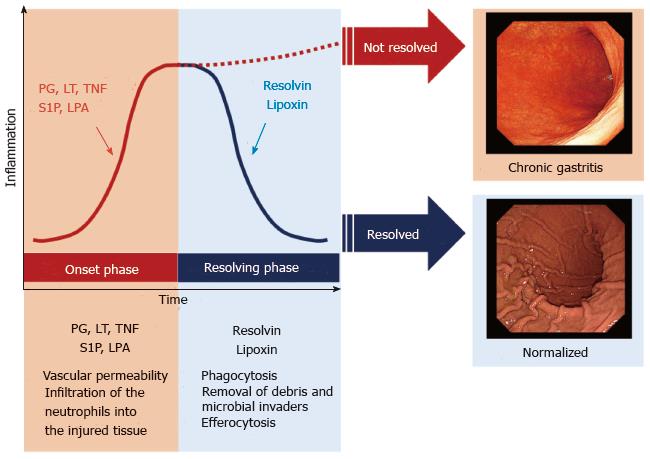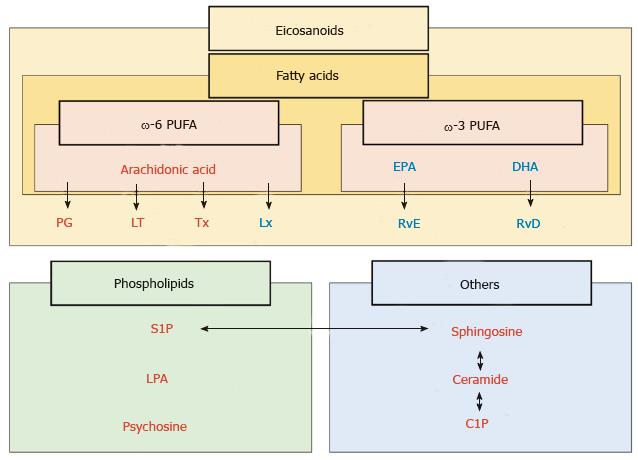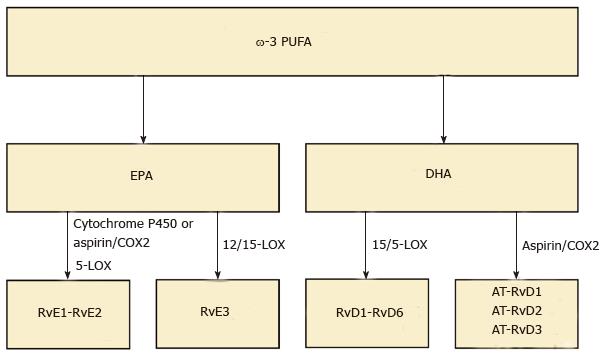Copyright
©The Author(s) 2016.
World J Clin Cases. Jul 16, 2016; 4(7): 155-164
Published online Jul 16, 2016. doi: 10.12998/wjcc.v4.i7.155
Published online Jul 16, 2016. doi: 10.12998/wjcc.v4.i7.155
Figure 1 A course of acute inflammation with two phases: The onset phase and the resolving phase.
Acute inflammation is caused by stresses such as tissue injuries, microbial infections or surgical intervention. There are two phases in acute inflammation: The onset phase, and the resolving phase. Usually, the inflammation is resolved through these phases. When the inflammation is not resolved, it develops diseases with chronic inflammation. For instance, inflammation in stomach caused by microbial infections follow a course of the two phases in acute inflammation. When the acute inflammation is not resolved through the resolving phase, it develops chronic gastritis. PG: Prostaglandins; LT: Leukotrienes; TNF: Tumor necrosis factor; S1P: Sphingosine-1-phosphate; LPA: Lysophosphatidic acid.
Figure 2 Classification of lipid mediators of inflammation.
Lipid mediators are classified with fatty acids, phospholipids and others. Among the fatty acids, eicosanoids are the derivatives of polyunsaturated fatty acids (PUFA), which are present in dietary sources, such as fish oil (ω-3 PUFA) and vegetable oil (ω-6 PUFA). ω-6 PUFA generates prostaglandins (PG), leukotrienes (LT), thromboxanes (Tx) and lipoxins (Lx). Resolvin originates from eicosapentaenoic acid (EPA) and docosahexaenoic acid (DHA), which are components of ω-3 PUFA. Resolvin derived from EPA and DHA are termed resolvin E (RvE) and resolvin D (RvD) series, respectively, both of which act as pro-resolving mediators. Phospholipids including sphingosine-1-phosphate (S1P) and lysophosphatidic acid (LPA) and others including ceramides and ceramide-1-phosphate (C1P) usually act as pro-inflammatory mediators. Red: Pro-inflammatory mediators; Blue: Pro-resolving mediators.
Figure 3 Classification of resolvins.
Resolvins are biosynthesized from ω-3 polyunsaturated fatty acids (PUFA) by specific enzymes including lipoxygenase (LOX). Resolvin E (RvE) is endogenously produced from eicosapentaenoic acid (EPA) during endothelial cell-leukocyte interaction. RvE1 and RvE2 are biosynthesized through two different pathways via cytochrome P450-driven oxygenation of EPA or via aspirin-acetylated cyclooxygenase 2 (COX-2). RvE3 is generated via the 12/15-LOX pathway. In addition, resolvin D (RvD) is biosynthesized from docosahexaenoic acid (DHA) via 15/5-LOX within vascular endothelial cells. To date, six members of this family has been identified RvD1-6. Also, RvD is also biosynthesized via aspirin-acetylated COX-2, and we call aspirin triggered RvD (AT-RvD).
- Citation: Moro K, Nagahashi M, Ramanathan R, Takabe K, Wakai T. Resolvins and omega three polyunsaturated fatty acids: Clinical implications in inflammatory diseases and cancer. World J Clin Cases 2016; 4(7): 155-164
- URL: https://www.wjgnet.com/2307-8960/full/v4/i7/155.htm
- DOI: https://dx.doi.org/10.12998/wjcc.v4.i7.155











